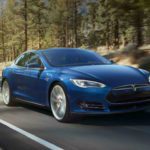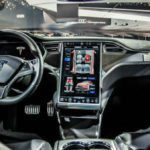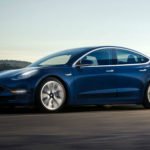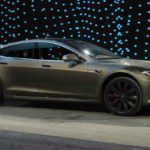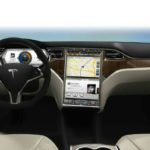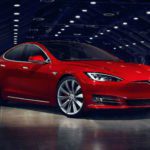2018 Tesla Model S
2018 Tesla Model S is a full-size luxury electric sedan that appears for the first time in Asphalt 8: Airborne. It is the only 5-door hatchback Tesla Motors in the range of models. The Tesla S 2018 Model is the only five-door car in the game that is an electric car and is the only electric sedan in the game. 2018 Tesla S Model is a low-end class D car with an initial range of 551, a maximum range of 877 and a final range of 938.
The Tesla Model S 2018 offers slower acceleration and a slower nitro thrust than the Audi R8 e-tron but has a longer lifespan. The maximum speed is also higher, what is interesting to note is that without the improvements, the Tesla S model has the same top speed as the Dodge GT. The S model is a very heavy hatchback, let alone the heavier electric car in the game, which makes it very bad in the corners. Its rear engine, the configuration of the rear propulsion further degrades its handling.
2018 Tesla Model S Features
All versions of the 2017 Model S models have the same body and normally accommodate five passengers. A third optional folding row turns into a two-seater rear-facing child seat with a five-point harness. Consumer Reports said the 7-passenger capacity provided by this option is larger than any other electric vehicle but not quite the same as a full-size SUV that can accommodate 7 adults. The two additional seats are reserved for children over 37 inches (940 mm) and weighing between 16 and 35 kg (35-77 kg), which the magazine called “a small size, too big for small children and Larger seats do not fit under the inclined glass. “The seats fold underneath the rear loading area, which Consumer Reports said was a” troublesome and embarrassing “operation, although for third-row seats, useful for extra occasional passengers when their children bring friends”, provided that the driver has planned and left the cargo area empty.While the rear seat option features a stronger rear bumper, the loader also indicated that sitting behind the rear axle on the S model, like any third-row seat, is an additional risk to rear impact.
The cargo space is available under the front hood, which Tesla calls “frunk”. In October 2014, the S model P85D, D was introduced for the double. The upgraded version has two electric motors, one that drives the rear wheels as in previous versions, and one that drives the front wheels. The twin-engine version will also be available for basic versions of 85 kWh. The rear-wheel-drive version of the P85 has been removed and the dual-engine option is not available for the 60 kWh version.
The model year update 2015 introduced the electromechanical brakes. In 2016, the 85 kWh and later 90 kWh battery was shut down in all markets. A glass roof without a horizontal roof bar between the B-pillars was introduced at the end of 2016. Before adding a glass roof option for the S-model, the possible roof options were: colored ceiling, ceiling painted in black or panoramic sunroof
2018 Tesla Model S Engine
The 2012 Tesla S model features a three-pole, four-pole, 310 hp and 443 pounds (600 Nm) four-pole electric motor with the copper rotor. The basic model uses a 362 hp (270 kW) and 325 ft·lb (440 N·m) engine. The company claimed a drag coefficient of Cd = 0.24, lower than any car when released. The independent measure by Car And Driver in May 2014 reinforces Tesla’s declaration, confirming exactly a drag coefficient of Cd = 0.24.
The S P90D has a top speed of 250 km/h and accelerates from 0 to 97 km/h in 2.8 seconds, despite the total engine power, in part thanks to the all-wheel-drive powertrain. The P85D, with all-wheel drive, has a top speed of 250 km / h and accelerates from 0 to 100 km/h (0 to 97 km/h) in 3.2 seconds (tested at 3 h, 1 second) under “Crazy Mode”, with 1g of acceleration. The latest P85Ds have an optional “Fun Mode” pack available with the 90 kWh battery update that improves acceleration from 0 to 97 km/h. 2.8 seconds and 1.1 g. The powertrain also provides a recuperative braking power of more than 60 kW which reduces energy consumption and improves brake life.
2018 Tesla Model S Battery
The standby state activates the energy saver display and the electronics of another vehicle, after the car, goes to sleep. This increases the time required for the touchscreen and dashboard to be usable. This mode can reduce the range of the car when not in use (3.7 km, 3.7 km per day, as of 2013).
- 2018 Tesla Model S Blue
- 2018 Tesla Model S Interior
- Tesla 2018 Model S
- 2018 Tesla Model S P100d
- Tesla Model S 2018 Interior
- Tesla Model S 2018
The 85 kWh battery weighs 1540 lb. and contains 7,104 lithium-ion batteries in 16 wired modules in series (14 in the flat section and two stacks in the front). Each module contains 6 groups of 74 cells wired in parallel; the 6 groups are then connected in series in the module. In June 2012, the battery used Panasonic cells modified with nickel-cobalt-aluminum cathodes. Each cell was form factor 18650, similar to the Panasonic NCR18650B cell with an energy density of 265 Wh / kg. Analysts estimate that the cost of the battery is about 21-22% of the cost of the car.
2018 Tesla Model S Safety
The Tesla Model S has a 5-star safety rating from Euro NCAP and the NHTSA (National Traffic Safety Administration). Only two other cars have won the same recognition since 2011. However, in July 2017, the Road Safety Institute (IIHS) found that, in frontal crash tests, Model S seat belts allow the driver to move too far forward. This problem has already been highlighted in one of the previous IIHS tests, to which Tesla replied that they would improve the design of their seat belts, which according to the IIHS been made. The IIHS also gave 2018 Tesla Model S the worst possible score for its projectors.

